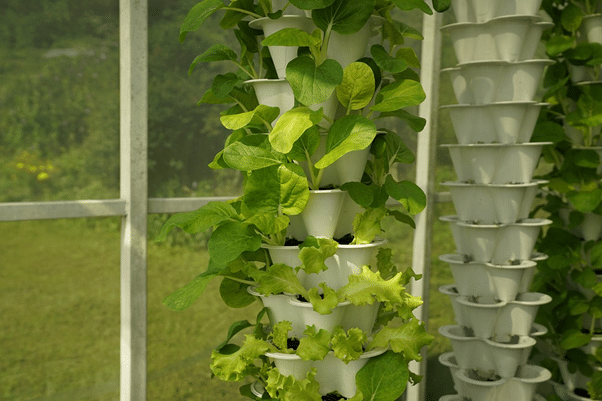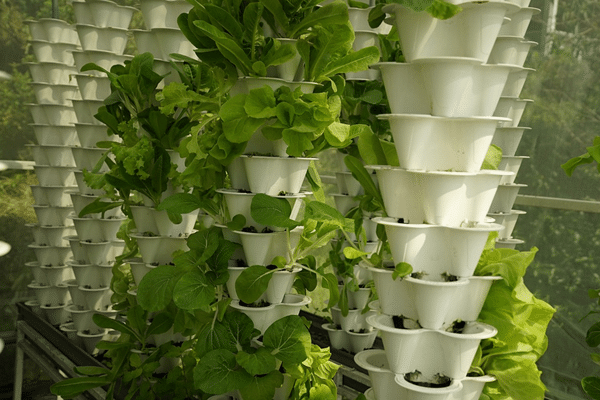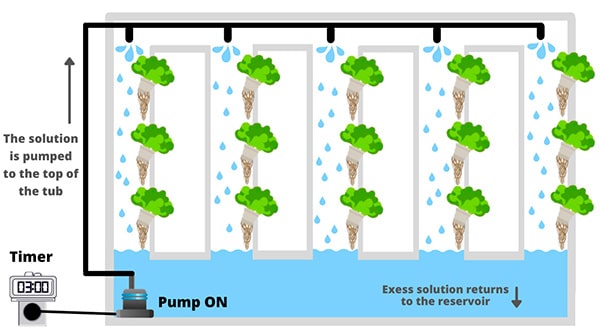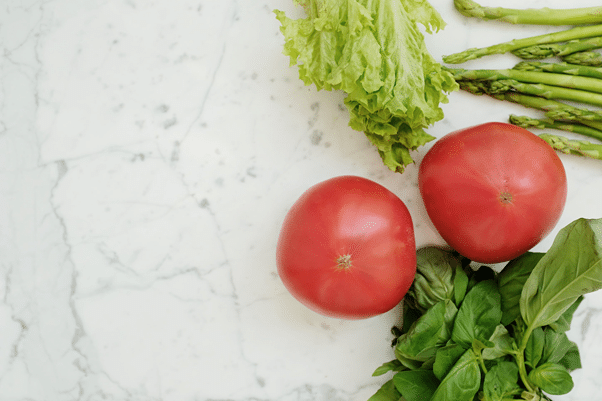How Much Water Does A Tower Garden Hold
I suppose you may have already tried gardening with unsatisfactory results. Lucky for you, tower gardens are different. No gardening experience is needed. That's why I decided to write this tutorial – to show that it's simple as ABC! All you need to start your garden is light from the sun or grow lights, electricity, water, about 30 minutes per week, and around three square feet. That's it!
Tower garden eliminates the need to dig, remove seeds, till, water, kneel and get dirty, making it simple and easy to maintain. The system can adapt to almost any location, including patios, terraces, porches, balconies, roofs, lounges, kitchens, and more. It comes with everything you need, along with a setup and growth guide so you can start your adventure right away.
Before start growing hydroponics herbs, veggies, leafy greens, you'll need to pick the right system to start with. Here are our suggestions: Our Picks for the 5 Hydroponic Towers in 2021, Picks for the 5 Best Aeroponics Systems with Buyer's Guides and Our Picks for the 5 Grow Tent Kits with Buyer's Guides.
Let me help you discover how to use an indoor Tower Garden!
What Is Indoor Tower Garden?

A tower garden is a clean, easy-to-use, and environmentally friendly Aeroponics upright grow machine. Simply put, this is an instant garden that can grow fruits and vegetables all year round in your home! Using the same technology used by NASA, these tower gardens can produce bigger plants in less time than usual gardening techniques.
Everyone knows that eating plenty of fruit and vegetables is good for you, but keeping the fridge stored can be expensive and impractical. Tower garden allows you to grow your own clean and living products at an affordable price so you can enjoy eating more of them more often. And tower garden's crops are more delicious and nutritious than those from grocery stores.
Most commercial products are cultivated using herbicides and pesticides and transported over long distances. This results in weekly products with reduced flavor and nutrients. When you cultivate yours, you can produce the way nature was designed – fresh, tasty, nutritious, and picked at the peak of maturity.
They don't need land, weeding, or excavation and remove most of the physical work from traditional gardening. Instead of obtaining nutrients naturally, plants in a garden turn used nutrient-rich water and a light system to effectively imitate this environment. They come with everything you need to start growing your garden; so, they're great for beginners or new gardeners!
How to Make an Indoor Tower Garden



There're different online sources for getting indoor garden systems, which may cost you nearly $500 or even more. Still, you can create your indoor tower garden for a more moderate budget. It can also be used to grow greenery at home once proper illumination is provided over the system, which is prevalent in communal zones with only a tiny room for cultivation.
Lights for Indoor Tower Garden
Whether indoors or outdoors, light is one of the key elements of a thriving garden. A good light source is essential if you're growing indoors. And the Tower Garden LED Grow Lights are as great as they can be.
Perhaps you have seen other growth lighthouses advertised in stores or online. Many of them produce too much warmth (which may burn you and/or your plants), use up too much energy, and generate poor illumination for good greenery growth.
However, Tower Garden culture lamps are specially designed to facilitate plant growth. And because they are LEDs, they remain freeze to the contact and use up less power (as little as $6.00 per month, depending on the energy).
You should run your grow lights for 14 to 18 hours each day and synchronize the cycle with your sleep routine (so that the light isn't on when you attempt to sleep). But keep in mind to make light for the plants a bit darker too! They need a rest because that's where they make a big part of their growth.
Be Moderate in Watering
You're probably going to find that your indoor garden tower should be filled every 10 to 20 days (depending on what you grow and where the plants are).
For softened water (i.e., water from a house water softener system), fill your tower garden with a reverse osmosis filter system or purchase distilled water. For chloric water, which includes the majority of tap liquid, hold the water in the sun for 48 hours.
You don't want to carry gallons of water from front to back, both the first time you fill the tank and every time you fill up the water. You'll therefore want to place the Tower in a location that can be accessed through a garden hose.
Look for the Perfect Place
If you had fresh food at hand while you were making meals, would you not eat more whole-food meals? I know that many producers have set up their Tower Gardens in their kitchens for that very reason. I have mine in my dining room, a few steps from my kitchen. And I go out collecting ingredients for lunch and dinner every day.
There's no room at home? Garages and greenhouses are also excellent options because they always protect against winter weather. No matter where you place it, make certain your tower garden is easy to reach. If you can't see it, you won't use it as much.
Get my lifehack: if you have wood floors, make sure to use a carpet, utility carpet, or similar barrier to avoid accidental water spillage that would damage the ground.
Only Lettuce, Leafy Vegetables, and Herbage Cultivation
The indoor cultivation is excellent. It's not limitless, though. One of the key limitations is that fruit crops typically don't grow well indoors. You see, there're several reasons for this: illumination, fertilization, and space.
Most fruit plants, such as squash, cucumbers, and tomatoes, become large, which means they're likely to shade other greenery and attain over and above the growing light on your soil. It's not the best either.
Tower Garden cultivates light-emitting illumination of fresh color, ideal for compact and bushy vegetative growth. However, fruit crops call for warm-colored light to produce flowers. This essentially means that your fruit crops will produce large, beautiful leaves, but they'll never flower, which plants have to do to produce fruit.
If you want to try growing fruit crops indoors anyway and already have the Tower Garden grow lamp kit, try to illuminate only fruit crops with a small projector-type bulb. For best results, use a light bulb that emits light between 2500 and 3000K.
Begin with Solid Seeds
First, strong and vigorous seeds must be used. Old or low-grade seeds often fail to germinate properly, take longer to grow, and produce weak plants. A good start is one of the excellent ways to provide a solid finish (i.e. plentiful harvests from your interior yard). What you can do to achieve this is to cultivate your plants from seeds.
There are numerous reasons for starting with seeds rather than getting seedlings. Still, when it comes to home gardening, probably the greatest advantage is that it will significantly reduce the potential for pest problems.
Harmful bacteria (or their eggs) always stop along the road with seedlings that are grown outdoors. And once they enter, they are difficult to eliminate since there's no naturally pure predator inside.
In case you're totally against seed farming, I suggest that you buy seedlings from a farm in the tower garden.
Indoor Garden Tower
A tower garden, also known as a window park, is a vertical hydroponic system, which comprises an A-form hydroponics system, hydroponics wall, and bottle cascades. You can use it to start different crops, such as strawberries, lettuces, herbage, spinach, broccoli, and petunia with flowers.
You want to cultivate your own fresh and healthy food. But something keeps you from doing it. Perhaps, you don't have a long growing season. Or your outer space does not receive sufficient sunlight. Or you don't even have an outside space. Sounds familiar?
Indoor gardening might be the way to go. This is the case for me. For the past four months, I have been cultivating kale, swiss chard, spinach, basil, coriander, and more in the corner of my dining room. I used to save a lot of money at the grocery store along the way. Would you like to do it the same way?
BONUS: How to Grow Tomatoes Indoors Step-by-Step Guide



We relish juicy summer tomatoes whenever we get a chance, but it doesn't have to stop when the time gets cold. As a matter of fact, you can get your yard full of tomatoes all year round without ever stepping out. How?
Put the Seeds into the Ground
Place a layer of cell planting mixture into a starter tray and moisten it. Plant the seeds (three or fewer per hole) to a depth of ¼" and place the tray on the heating mat (if you don't have it, put the tray in a place that is always hot).
Transfer Plants
After about a month, separate and transfer the plants into the large pot. Use the same selling, planting mixture to encircle the plants. Move them in the sunlight and place the LED light over the plants for gray days and additional warmth in cooler months.
Place Stakes in Pots to Keep Grape Vines Growing
If the plants are coming out, move them to a larger one. Encourage your tomatoes to grow upwardly at all times.
Pick Up Tomatoes before They Get Ripe
This diminishes fracture (this is when they get an ugly white slit on the side) and damage to insects because insects are attracted by the smell of ripe fruit.
How Many Tomato Plants Can Be in a Tower?
Regardless of the size of the tower, planting up to four plants per turn is recommended. Tomato greenery can also grow in a tower garden while leaving the vines crawling on the ground.
Tomatoes planted too close to one another are more likely to have problems, for instance, disease – many plant diseases spread on wet leaves. If tomatoes are placed so close to each other that sunlight and air cannot dry out the leaves, plants will be more susceptible to developing harmful diseases.
Conclusion
That's all I have for you today. Now, you know how to use an indoor tower garden. I wrote this article since I adore gardening. I like finding new ways to grow my favorite plants. And one time, I was a beginner in hydroponics like you. I wish I had had some guidance. Today, my goal was to share my ideas with you and to help you to use an indoor tower garden. Let me know if you liked the post in the comments below and share it, if yes!
FAQ
How Often Should You Water a Tower Garden?
The inner garden tower should be filled every 10 to 20 days depending on what you're growing and where the plants are. You don't want to carry liters of water from the front to the back, both the first time you fill the reservoir and each time you fill the water. You'll therefore feel like placing the tower in a place accessible by a garden hose.
Is Tower Garden Healthy?
Research has shown that people eat what they cultivate. Speaking of food, you'll probably find that your abundant tower garden harvests are more delicious and nutritious than groceries. Given that the soil is a prerequisite for organic cultivation, and aeroponic systems don't use soil, tower gardens cannot be categorized as organic. But instead of cultivating in the ground, they use water, oxygen, and absolute natural minerals to deliver nutriment straight to the roots of the greenery.
How Do I Put Plants in the Tower Garden?
Figure out the best place to grow up. Choose the right plants according to your taste and growing conditions. Replenish supplies as required. Generally speaking, you have to organize plants as a pyramid. Put bigger plants and vining, such as squash and tomatoes, on the bottom (and avoid planting more than 4 of them because they can evict other plants). Next, place smaller greenery, such as lettuce and herbs, above the top.
How Many Worms Do I Need for a Garden Tower?
There are two common types of organic fertilizer worms, and these are red wiggler worms and European Nightcrawlers. But the most favorable composting worm is said to be the first, the yellow worm. Use 250-500 red wiggler worms to begin, or 25-50 earthworms. Red whorls go through the compost tube, and earthworms go through the soil column. Free them anywhere in the system, and they'll eventually get to where they do their best work.
How Much Electricity Does a Tower Garden Use?
Approximately, it's about 278 watts per round per day. Tower Farm pumps have a rated capacity of 58 watts per hour. And operating the pump on the recommended 3-minute walk/12-minute rest cycle represents up to 4.8 hours a day. So, many farmers say that a tower garden is paid for in less than two years by reducing grocery expenses.
Can You Grow Strawberries in a Tower Garden?
I strongly recommend cultivating strawberries in a tower garden whether for personal or commercial purposes. In my experience, cultivating strawberries of the soil in a tower garden has never needed pesticide spraying. The same cannot be said for strawberries that I grow in the soil in comparative trials. All types of strawberries can be cultivated in a tower garden. The harvest is abundant, and the fruits are juicy and very tasty.
How Do You Check the PH of a Tower Garden?
Check your tower garden once or twice a week to make sure that pH is between 5.5 and 6.5. As plants grow, their pH can fluctuate. After adding nutrients, measure the pH with the test kit included with your tower garden and adjust it as needed. Fill the bottle with 5 ml of tower garden water. Pour 5 drops of the solution into the bottle and compare the color with the test tape.
Can I Leave Seedlings Out Overnight?
For the first night, take them indoors. On the second night, bring them indoors unless the cold weather forecast is particularly mild. By their third night, they'll have begun to harden a bit and can remain outside in a protected place, maybe against the wall of the house. Finally, allow your plants to remain in full sun and outdoors all night long as night temperatures do not fall under frost. So, keep bringing it inside if nights stay cool.
Can I Plant Peas and Tomatoes Together?
Brassica, such as broccoli and cabbage, are plants that should not be shared with tomatoes. Maize is another solid "no" as it tends to draw the tomato fruit maggot and/or corncob worm. Kohlrabi prevents the tomatoes from growing, and planting tomatoes and potatoes increases the risk of potato fire blight. The list of recommended plants for placing together with tomatoes includes peas, carrots, lettuce, mint, onion, and so on.
What Helps Plants Grow Straight?
Plant become tangled in a place that becomes more shaded. You should either remove the obstacle causing the shade or move the plant to a different place. Tie the plant and pile it together with vegetable ribbon, ribbon, or other soft material. Don't force the plant completely vertically; just a little more vertical than it used to be. The plant should be formed to stand upright rather than forced into a non-natural position.
How Much Water Does A Tower Garden Hold
Source: https://hydrogardengeek.com/indoor-tower-garden/
Posted by: pendletonexagagaidid.blogspot.com





0 Response to "How Much Water Does A Tower Garden Hold"
Post a Comment